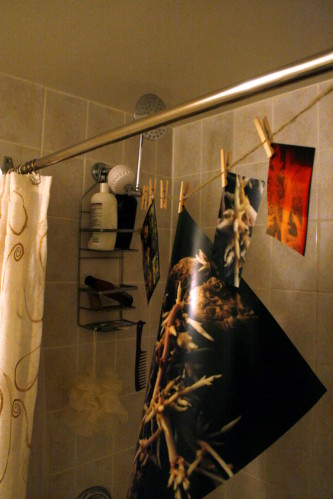INTRODUCTION
This guide is for
those
interested in setting up a home colour darkroom! More specifically, for
printing colour film onto colour-negative (RA-4 process) paper. This
guide will not cover developing of colour negatives (C-41 process), and
assumes that you have access to a lab that will process your negatives
for you.

Contrary to popular belief, the task is not inordinately difficult. It is in actuality, highly cost effective, especially given the outpouring of old darkroom equipment on the used market for relatively no cost at all. Indeed, putting together a colour darkroom is no more difficult than putting together a black & white darkroom. In addition, a colour darkroom setup is perfectly capable of supporting a black & white workflow! The cost of consumable material such as paper and chemistry is very low (orders of magnitude less expensive than inkjet paper and ink!), and achievable image quality through optical printing is practically unparalleled, especially when cost is considered!
CLEARING THE AIR
Common misconceptions about colour printing (popular deterrents):
“But
it requires extremely precise temperature control (94F/34C)”
- While some degree of temperature control is necessary, and Kodak’s datasheets recommend processing at the above temperatures, practical experience is that temperature consistency is the most important factor. You can make prints at room temperature – just make sure you stick to it!
- Not really. The two chemical steps used in colour printing (1.Color Developer, 2. Bleach/Fix) are no more harmful than the standard black and white Developers/Fixers. In fact, if you process black & white paper archivally, you are in much worse territory!
“Colour
chemicals are extremely expensive and impossible to find!”
- Not quite. In Canada, RA-4 chemistry is a bit more difficult to source than in the U.S, however, I recently discovered Photo Central (www.darkroomcentral.ca). 10L kits of both Developer and Blix run about $70 combined, which, for personal use, will take you through several large boxes of paper, to say the least.
- If you’re silly about it! There are several tricks to keep chemicals fresh for a long time:
1) Make small
batches of working solution. Stock solution keeps much better than
working solution. (Don’t mix 10L of working solution at once unless you
plan on hosting an orgy of binge printers. (In which case, I hope I am
invited.))
“Setting up a colour darkroom/printing yourself is too expensive! Why bother?”
-
I’ve seen complete colour darkroom outfits being sold on craigslist for less than $100. A box of 50 16x20” RA-4 paper is roughly $70. Factoring in chemistry, it costs about $1.75 for each 16x20” print you make. Compare that to lab printing, or worse, a home inkjet setup.
"Setting
up a colour darkroom is difficult. The learning curve is too great."
- I recently assisted a friend in printing some of her
digital photographs at a popular photo finishing chain. She did not
have a colour calibrated monitor. Oddly enough, their monitors were not
quite calibrated either. After spending almost three hours rejecting
proofs and pissing off the staff, we compromised on a couple of 4x6's
when the original intent was to print several 8x12's. The point being,
making good prints will require a learning curve regardless of whether
you're learning to print yourself, or whether you're learning how to
squeeze good prints out of photo finishing labs!